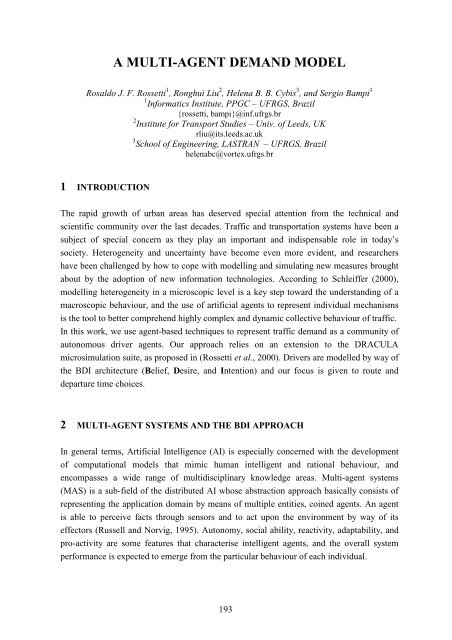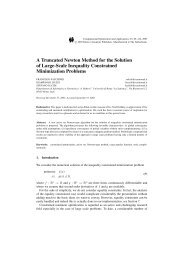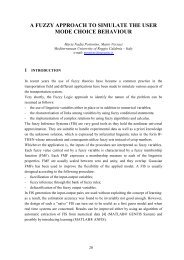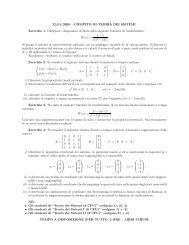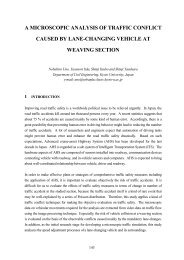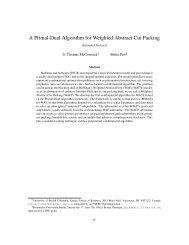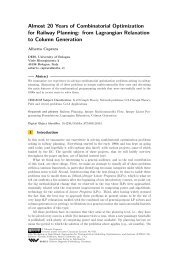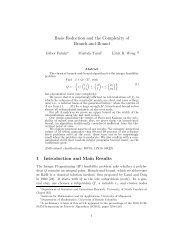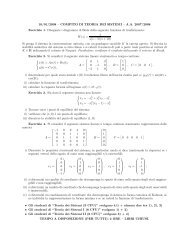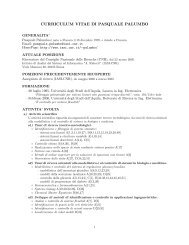A MULTI-AGENT DEMAND MODEL - UFRGS
A MULTI-AGENT DEMAND MODEL - UFRGS
A MULTI-AGENT DEMAND MODEL - UFRGS
Create successful ePaper yourself
Turn your PDF publications into a flip-book with our unique Google optimized e-Paper software.
A <strong>MULTI</strong>-<strong>AGENT</strong> <strong>DEMAND</strong> <strong>MODEL</strong><br />
Rosaldo J. F. Rossetti 1 , Ronghui Liu 2 , Helena B. B. Cybis 3 , and Sergio Bampi 1<br />
1 Informatics Institute, PPGC – <strong>UFRGS</strong>, Brazil<br />
{rossetti, bampi}@inf.ufrgs.br<br />
2 Institute for Transport Studies – Univ. of Leeds, UK<br />
rliu@its.leeds.ac.uk<br />
3 School of Engineering, LASTRAN – <strong>UFRGS</strong>, Brazil<br />
helenabc@vortex.ufrgs.br<br />
1 INTRODUCTION<br />
The rapid growth of urban areas has deserved special attention from the technical and<br />
scientific community over the last decades. Traffic and transportation systems have been a<br />
subject of special concern as they play an important and indispensable role in today’s<br />
society. Heterogeneity and uncertainty have become even more evident, and researchers<br />
have been challenged by how to cope with modelling and simulating new measures brought<br />
about by the adoption of new information technologies. According to Schleiffer (2000),<br />
modelling heterogeneity in a microscopic level is a key step toward the understanding of a<br />
macroscopic behaviour, and the use of artificial agents to represent individual mechanisms<br />
is the tool to better comprehend highly complex and dynamic collective behaviour of traffic.<br />
In this work, we use agent-based techniques to represent traffic demand as a community of<br />
autonomous driver agents. Our approach relies on an extension to the DRACULA<br />
microsimulation suite, as proposed in (Rossetti et al., 2000). Drivers are modelled by way of<br />
the BDI architecture (Belief, Desire, and Intention) and our focus is given to route and<br />
departure time choices.<br />
2 <strong>MULTI</strong>-<strong>AGENT</strong> SYSTEMS AND THE BDI APPROACH<br />
In general terms, Artificial Intelligence (AI) is especially concerned with the development<br />
of computational models that mimic human intelligent and rational behaviour, and<br />
encompasses a wide range of multidisciplinary knowledge areas. Multi-agent systems<br />
(MAS) is a sub-field of the distributed AI whose abstraction approach basically consists of<br />
representing the application domain by means of multiple entities, coined agents. An agent<br />
is able to perceive facts through sensors and to act upon the environment by way of its<br />
effectors (Russell and Norvig, 1995). Autonomy, social ability, reactivity, adaptability, and<br />
pro-activity are some features that characterise intelligent agents, and the overall system<br />
performance is expected to emerge from the particular behaviour of each individual.
In this work, we approach the task of modelling demand and representing driver behaviour<br />
by the adoption of agent-based techniques. Each driver is modelled as a rational agent<br />
featuring a BDI reasoning model, which was conceived on the basis of the framework<br />
proposed by Rao and Georgeff (1991). The underlining idea of their theory is the<br />
understanding of practical reasoning as the process of deciding, moment by moment, which<br />
action to perform in the furtherance of the individual’s goals (Wooldridge, 1999). As briefly<br />
described by Wooldridge (1999), a BDI agent is composed of base beliefs that represent the<br />
information about its environment (beliefs are updated through perceptions). On the basis of<br />
current beliefs and current intentions, an option generation function evaluates the options<br />
available to the agent (its desires). Current options represent possible courses of action, and<br />
a deliberation process determines the agent’s new intentions on the basis of its current<br />
beliefs, desires, and intentions (states of affair that it has committed to trying to bring<br />
about).<br />
In order to turn theory into practice, Rao (1996) specified the AgentSpeak(L) language to<br />
support the construction of BDI agents. Albeit it has not, as yet, been actually implemented,<br />
Machado and Bordini (2001) suggest AgentSpeak(L) also serves as a specification language<br />
for representing BDI agent models, which we have experienced in previous work (Rossetti<br />
et al., 2001). In practice, modelling a BDI agent in AgentSpeak(L) is accomplished simply<br />
by means of identifying its base beliefs and a set of non-instantiated plans. Intentions are<br />
dynamically generated during the reasoning process. Readers are referred to (Rao, 1996) for<br />
a detailed explanation and formal specification of the BDI logics and AgentSpeak(L).<br />
We have used JAM (Huber, 1999) to implement our demand model, which was specified in<br />
AgentSpeak(L). JAM is a Java-based architecture that combines the aspects of several<br />
leading-edge agent theories and intelligent agent frameworks, including the BDI logics. We<br />
rely on the operational semantics and on the constructors of JAM to implement and test our<br />
multi-agent demand approach. Another way for practical implementation of AgentSpeak(L)<br />
models is presented in (Machado and Bordini, 2001).<br />
3 MADAM: THE <strong>DEMAND</strong> <strong>MODEL</strong><br />
MADAM (Multi-Agent DemAnd Model) is an agent-based model aimed at representing<br />
variability in traffic demand by means of a population of BDI driver agents. Our approach<br />
relies on an extension to DRACULA (Dynamic Route Assignment Combining User<br />
Learning and microsimulAtion), which is a microscopic traffic simulation suite that has<br />
been developed in the Institute for Transport Studies, University of Leeds, UK (Liu et al.,<br />
1995).<br />
A key ingredient in the DRACULA model is variability, which rises from two centrally<br />
important concepts, namely the day-to-day dynamics and the within-day decision making<br />
process. The former is concerned with modelling how the state of the network changes over
time, as the spatial knowledge of a driver is constantly evolving in response to trips made<br />
through the network. The latter deals with choices regarding the journey, made by each<br />
individual on a daily basis.<br />
As in conventional models, the approach used in DRACULA begins with the concept of<br />
demand and supply (Liu et al., 1995). In the demand model, trip makers are represented in<br />
terms of their individual choices, whereas the microscopic simulation of vehicles moving<br />
through the network is represented in the supply side. MADAM replaces the demand model;<br />
rather than representing travel choices through variable values in a simple data structure,<br />
demand results from the cognition process of each single BDI driver agent.<br />
We focus on the departure time and route choices, following the decision-making<br />
approaches currently implemented in DRACULA, as presented in (Liu et al., 1995).<br />
Departure time is chosen in response to traveller’s previous experiences and preferred<br />
arrival time. The absolute delay for a driver m travelling from origin i to destination j on day<br />
k is given in Equation 1, where d ijm (k) is the departure time, t ijm (k) is the travel time, and a<br />
ijm (k) is the desired arrival time. Drivers are also assumed to be indifferent to a delay of e mt<br />
ijm (k) (relative to the travel time experienced). Equation 2 represents the lateness perceived by<br />
individuals.<br />
δ ijm (k) = d ijm (k) + t ijm (k) – a ijm (k) (1)<br />
∆ (k) ijm = δ (k) ijm – e mt ijm (k) (2)<br />
As suggested in (Mahmassani et al., 1991), drivers are likely to be indifferent to early<br />
arrivals. Bearing this in mind, we consider that users only adjust their departure time for a<br />
future journey in the case of ∆ (k) ijm > 0, otherwise they will keep the same departure time.<br />
The adjustment is made as in Equation 3.<br />
d ijm (k+1) = d ijm (k) (k)<br />
– ∆ ijm (3)<br />
The route choice also follows the model implemented in DRACULA (Liu et al., 1995),<br />
which is the “boundly rational choice” based on the work presented by Mahmassani and<br />
Jayakrishnan (1991). Drivers are assumed to use their habit routes as on the last day, unless<br />
the cost expected for the minimum cost route is significantly better. Thus, a driver will use<br />
the same route unless C p1 – C p2 > max(η × C p1 , τ), where C p1 and C p2 are the costs along<br />
the habit and the minimum cost routes, respectively, and η and τ are global parameters<br />
representing the relative and the absolute cost improvement required for a route switch. This<br />
model is the basis for the BDI driver agent, which is described by means of a set of base<br />
beliefs and a set of plans.<br />
4 A SIMULATION FRAMEWORK<br />
MADAM is implemented in Java to support the JAM-based driver agents, and replaces the<br />
original demand sub-model of DRACULA, as shown in Figure 1. On the demand side, day-
to-day variability is represented in terms of individuals that have decided to travel on a<br />
certain day. Decision-making is driven by mental attitudes of each of our BDI agents. MA<br />
Initialisation synthesises a population of agent drivers from an OD matrix and sets the<br />
initial base beliefs for each individual including possible routes for each origin-destination<br />
pair (possible routes are identified at the beginning of the simulation). The demand on each<br />
day is built up from the population and is formed by drivers who have decided to travel on<br />
that day. The Input MA file gathers drivers’ route and departure time choices, so that they<br />
can be launched onto the network to perform their journeys. The Output MA file returns the<br />
travel costs (given in terms of the travel time experienced) for each driver in the demand<br />
yielding an update of the base beliefs. In the supply module, dracprep is responsible for<br />
setting supply day variability whereas dracsim simulates the microscopic movement.<br />
yes: stop simulation<br />
Routes OD Matrix<br />
MA Initialisation<br />
population<br />
of<br />
BDI drivers<br />
demand<br />
End?<br />
Input MA<br />
Output MA<br />
no<br />
DRACPREP<br />
DRACSIM<br />
MADAM<br />
(demand)<br />
DRACULA<br />
(supply)<br />
Figure 1. The simulation framework<br />
We have carried out a simple simulation in order to test our approach. The network used as<br />
the testing environment consists of 11 origin-destination pairs, 12 priority and two<br />
signalised junctions. A total of 2323 driver agents were generated and simulated over a<br />
period of 50 days (30 min spreading period on each day). Departure time, arrival time,<br />
desired arrival time, and travel time for a driver of the population are plotted on the graph of<br />
Figure 2, illustrating the approach adopted for the departure time choice.
A BDI Driver Agent<br />
40<br />
time (min)<br />
30<br />
20<br />
10<br />
Departure Time<br />
Arrival Time<br />
Desired Arrival<br />
Travel Time<br />
0<br />
0 5 10 15 20 25 30 35 40 45 50<br />
days<br />
Figure 2. Departure time decisions of a BDI driver agent over a period of 50 days<br />
5 CONCLUSIONS<br />
We have devised an agent model on the basis of the driver behaviour currently implemented<br />
in DRACULA. In such an approach, demand is built up by means of BDI drivers that reason<br />
about departure time and route options, as well as on their needs for travelling on a certain<br />
day. The use of mental attitudes, such as beliefs, desires, and intentions allowed for an<br />
appropriate representation of drivers’ cognition on trip parameters. The MADAM structure<br />
is also flexible to support different behaviour models by way of simply specifying new sets<br />
of beliefs and plans. The very next steps in this project are the validation and the<br />
improvement of our BDI driver model and the simulation of more realistic scenarios with<br />
the analysis of aggregate parameters. Further developments also include the assessment of<br />
drivers’ response to exogenous information, such as those provided by Advanced Traveller<br />
Information Systems (ATIS) and Variable Message Signs, as suggested in (Rossetti et al.,<br />
2001). We also intend to formalise and develop a more elaborated learning model as a way<br />
of improving decision-making.<br />
ACKNOWLEDGEMENTS<br />
We gratefully thank Dr. Dirck Van Vliet and Dr. Rafael H. Bordini for their invaluable<br />
comments and suggestions. This project has been financially supported by CNPq and<br />
CAPES, the Brazilian agencies for R&D.
REFERENCES<br />
Huber, M.J. (1999) JAM: a BDI-theoretic mobile agent architecture. Proc. of the 3rd International Conference<br />
on Autonomous Agents, Agents’99. Seattle, May 1999. pp.236-243.<br />
Liu, R., D. Van Vliet, and D.P. Watling (1995) DRACULA: dynamic route assignment combining user<br />
learning and microsimulation. Proc. of the 23rd European Transport Forum, PTRC. Vol. E, pp.143-152.<br />
Machado, R. and R.H. Bordini (2001) Running AgentSpeak(L) agents on SIM-<strong>AGENT</strong>. Proc. of the<br />
International Workshop on Agents Theories, Architectures, and Languages (ATAL’01). Seattle, 1-3 Aug. 2001.<br />
Mahmassani, H.S. and R. Jayakrishnan (1991) System performance and user response under real-time<br />
information in a congested traffic corridor. Transportation Research 25A, 293-308.<br />
Mahmassani, H.S., S.G. Hatcher, and C.G. Caplice (1991) Daily variation of trip chaining, scheduling, and<br />
path selection behaviour of work commuters. Proc. of the 6th International Conference on Travel Behavior.<br />
Quebec City, 22-24 May 1991.<br />
Rao, A.S. (1996) BDI agents speak out in a logical computable language. Proc. of the 7th European Workshop<br />
on Modelling Autonomous Agents in a Multi-Agent World. Heidelberg: Springer-Verlag (LNAI 1038). pp.42-<br />
55.<br />
Rao, A.S. and M.P. Georgeff (1991) Modeling rational agents within a BDI architecture. Proc. of the<br />
International Conference on Principles of Knowledge Representation and Reasoning (KR-91). San Mateo:<br />
Morgan Kaufmann. pp.473-484.<br />
Rossetti, R.J.F, S. Bampi, R. Liu, D. Van Vliet, and H.B.B. Cybis (2000) An agent-based framework for the<br />
assessment of drivers’ decision-making. Proc. of the 3rd Annual IEEE Conference on Intelligent<br />
Transportation Systems. Dearborn, 1-3 Oct. 2000. pp.387-392.<br />
Rossetti, R.J.F., R.H. Bordini, A.L.C. Bazzan, S. Bampi, R. Liu, and D. Van Vliet (2001) Using BDI agents to<br />
improve driver modelling in a commuter scenario. Transportation Research Part C. (forthcoming in a special<br />
issue on Intelligent Agents in Traffic and Transportation).<br />
Russell, S.J. and P. Norvig (1995) Artificial Intelligence: a modern approach. Englewood Cliffs: Prentice-<br />
Hall, Inc. 1995.<br />
Schleiffer, R. (2000) Traffic itself is simple – just analyzing it is not. Proc. of the 33th Annual Hawaii<br />
International Conference on System Sciences (HICSS-33). Maui, 4-7 Jan. 2000.<br />
Wooldridge, M. (1999) Intelligent agents. In: G. Weiss (editor) Multiagent Systems: a modern approach to<br />
distributed artificial intelligence. Cambridge: The MIT Press. pp.27-77.


